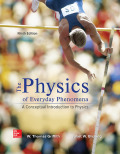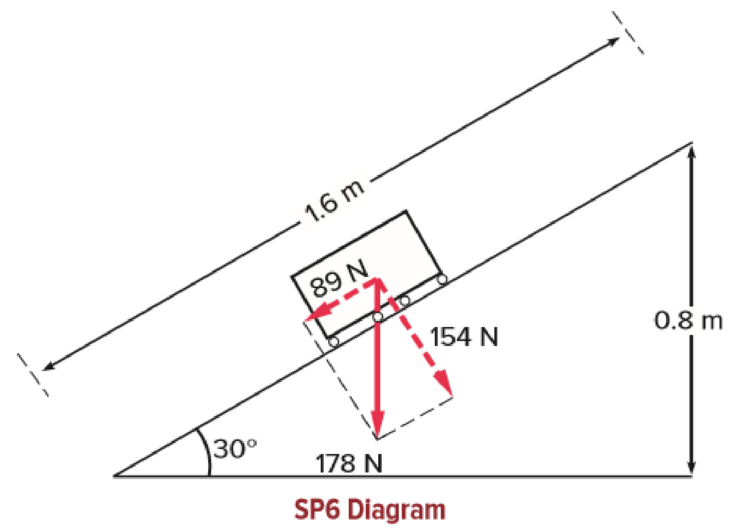
Concept explainers
Suppose you wish to compare the work done by pushing a box on rollers up a ramp to the work done if you lift the box straight up to the same final height.
- a. What work is required to lift a 178-N box (about 40 lbs) up to a table which is 0.8 m off the floor?
- b. Let’s assume you also have a ramp available that makes an angle of 30° with the horizontal, as shown in the figure below. The ramp is 1.6 m long. The weight of the box (178 N) is due to the Earth’s pulling on the box. This 178 N is a force directed straight down. If you push it up a ramp, you are doing work against only the component of this weight along the ramp, which is 89 N, as shown in the diagram. How much work does it require to push the box up the ramp, assuming no friction?
- c. Which situation (pushing up the ramp or lifting straight up) requires more work?
- d. Which situation requires more force?
- e. For which situation is the distance moved greater?
- f. What is the change in the gravitational potential energy of the box for each situation?
- g. What advantage, if any, is there to using the ramp? Explain.

(a)
The work required to lift the box.
Answer to Problem 6SP
The work required to lift the box is
Explanation of Solution
Given info: The force over the box is
Write the expression for work done when force applied force and the displacement are in the same direction.
Here,
Since the gravitational force over the box is
Substitute
Conclusion:
Therefore, the work required to lift the box is
(b)
The amount of work required to push the box up the ramp.
Answer to Problem 6SP
The amount of work required to push the box up the ramp is
Explanation of Solution
Given info: The diagram is given in the question. The distance of the ramp is
Since the component of the weight (gravitational force) along the ramp is
Write the expression for work done when force applied force and the displacement are in the same direction.
Substitute
Conclusion:
Therefore, the amount of work required to push the box up the ramp is
(c)
Which among the situations, pushing up the ramp or lifting straight up required more work.
Answer to Problem 6SP
The amount of work required for both pushing up the ramp and lifting straight up is the same.
Explanation of Solution
Given info: The work required to lift the box is
It is obtained that the work required to lift the box straight up is
Conclusion:
Therefore, the amount of work required for both pushing up the ramp and lifting straight up is the same.
(d)
Which among the situations, pushing up the ramp or lifting straight up required more force.
Answer to Problem 6SP
Lifting the box straight up required more force than pushing it up the ramp.
Explanation of Solution
Given info: The force over the box is
Since the gravitational force over the box is
Conclusion:
Therefore, lifting the box straight up required more force than pushing it up the ramp.
(e)
Which among the situations, pushing up the ramp or lifting straight up, the distance moved is greater.
Answer to Problem 6SP
The distance moved is greater in pushing the box up the ramp than that in lifting the box straight up.
Explanation of Solution
Given info: The work done for both the situations is
By definition, the work done by a force is equal to the product of force and the displacement of the object in the direction of application of force. Here, in both the situations, the work done is same but the force required is greater in lifting the box up the ramp. The force is applied over a long distance when the box is pushed up the ramp.
Conclusion:
Therefore, the distance moved is greater in pushing the box up the ramp than that in lifting the box straight up.
(f)
The change in the gravitational potential energy of the box for lifting the box straight up and pushing it up the ramp.
Answer to Problem 6SP
The change in the gravitational potential energy of the box for lifting the box straight up and pushing it up the ramp is
Explanation of Solution
Given info: The height of the final position of the box is
Since the same box is considered in both the situations, the mass
Write the expression gravitational force on the object.
Here,
Substitute
Write the expression for the change in gravitational potential energy.
Here,
Since in both processes, the box is moved from the initial ground level to a final height of
Substitute
Thus, the change in the gravitational potential energy of the box for lifting the box straight up and pushing it up the ramp is
Conclusion:
Therefore, the change in the gravitational potential energy of the box for lifting the box straight up and pushing it up the ramp is
(g)
The advantage of using the ramp to move the box.
Answer to Problem 6SP
When the ramp is used to move the box to the given height, less force is required than lifting it straight up to the height and hence the strength of the person doing work can be conserved using the ramp.
Explanation of Solution
As obtained in the calculations, the force required to move the box to the final position is
Conclusion:
Therefore, when the ramp is used to move the box to the given height, less force is required than lifting it straight up to the height and hence the strength of the person doing work can be conserved using the ramp.
Want to see more full solutions like this?
Chapter 6 Solutions
Physics of Everyday Phenomena
- A long, straight wire carries a current of 10 A along what we’ll define to the be x-axis. A square loopin the x-y plane with side length 0.1 m is placed near the wire such that its closest side is parallel tothe wire and 0.05 m away.• Calculate the magnetic flux through the loop using Ampere’s law.arrow_forwardDescribe the motion of a charged particle entering a uniform magnetic field at an angle to the fieldlines. Include a diagram showing the velocity vector, magnetic field lines, and the path of the particle.arrow_forwardDiscuss the differences between the Biot-Savart law and Coulomb’s law in terms of their applicationsand the physical quantities they describe.arrow_forward
- Explain why Ampere’s law can be used to find the magnetic field inside a solenoid but not outside.arrow_forward3. An Atwood machine consists of two masses, mA and m B, which are connected by an inelastic cord of negligible mass that passes over a pulley. If the pulley has radius RO and moment of inertia I about its axle, determine the acceleration of the masses mA and m B, and compare to the situation where the moment of inertia of the pulley is ignored. Ignore friction at the axle O. Use angular momentum and torque in this solutionarrow_forwardA 0.850-m-long metal bar is pulled to the right at a steady 5.0 m/s perpendicular to a uniform, 0.650-T magnetic field. The bar rides on parallel metal rails connected through a 25-Ω, resistor (Figure 1), so the apparatus makes a complete circuit. Ignore the resistance of the bar and the rails. Please explain how to find the direction of the induced current.arrow_forward
- For each of the actions depicted, determine the direction (right, left, or zero) of the current induced to flow through the resistor in the circuit containing the secondary coil. The coils are wrapped around a plastic core. Immediately after the switch is closed, as shown in the figure, (Figure 1) in which direction does the current flow through the resistor? If the switch is then opened, as shown in the figure, in which direction does the current flow through the resistor? I have the answers to the question, but would like to understand the logic behind the answers. Please show steps.arrow_forwardWhen violet light of wavelength 415 nm falls on a single slit, it creates a central diffraction peak that is 8.60 cm wide on a screen that is 2.80 m away. Part A How wide is the slit? ΟΙ ΑΣΦ ? D= 2.7.10-8 Submit Previous Answers Request Answer × Incorrect; Try Again; 8 attempts remaining marrow_forwardTwo complex values are z1=8 + 8i, z2=15 + 7 i. z1∗ and z2∗ are the complex conjugate values. Any complex value can be expessed in the form of a+bi=reiθ. Find θ for (z1-z∗2)/z1+z2∗. Find r and θ for (z1−z2∗)z1z2∗ Please show all stepsarrow_forward
- Calculate the center of mass of the hollow cone shown below. Clearly specify the origin and the coordinate system you are using. Z r Y h Xarrow_forward12. If all three collisions in the figure below are totally inelastic, which will cause more damage? (think about which collision has a larger amount of kinetic energy dissipated/lost to the environment? I m II III A. I B. II C. III m m v brick wall ע ע 0.5v 2v 0.5m D. I and II E. II and III F. I and III G. I, II and III (all of them) 2marrow_forwardCan you solve this 2 question teach me step by step and draw for mearrow_forward

 Physics for Scientists and Engineers: Foundations...PhysicsISBN:9781133939146Author:Katz, Debora M.Publisher:Cengage Learning
Physics for Scientists and Engineers: Foundations...PhysicsISBN:9781133939146Author:Katz, Debora M.Publisher:Cengage Learning College PhysicsPhysicsISBN:9781305952300Author:Raymond A. Serway, Chris VuillePublisher:Cengage Learning
College PhysicsPhysicsISBN:9781305952300Author:Raymond A. Serway, Chris VuillePublisher:Cengage Learning Glencoe Physics: Principles and Problems, Student...PhysicsISBN:9780078807213Author:Paul W. ZitzewitzPublisher:Glencoe/McGraw-Hill
Glencoe Physics: Principles and Problems, Student...PhysicsISBN:9780078807213Author:Paul W. ZitzewitzPublisher:Glencoe/McGraw-Hill College PhysicsPhysicsISBN:9781938168000Author:Paul Peter Urone, Roger HinrichsPublisher:OpenStax College
College PhysicsPhysicsISBN:9781938168000Author:Paul Peter Urone, Roger HinrichsPublisher:OpenStax College College PhysicsPhysicsISBN:9781285737027Author:Raymond A. Serway, Chris VuillePublisher:Cengage Learning
College PhysicsPhysicsISBN:9781285737027Author:Raymond A. Serway, Chris VuillePublisher:Cengage Learning





